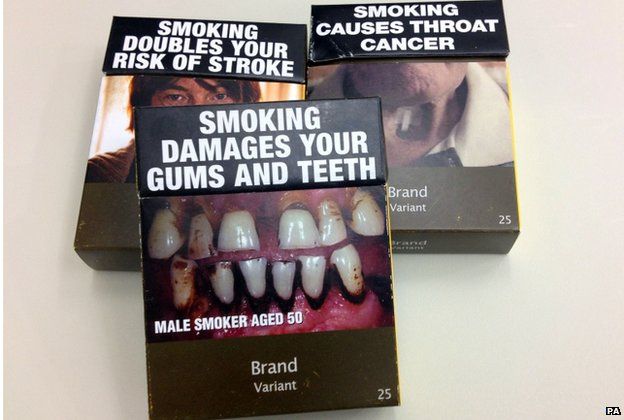Smoke clears on cigarette packaging debate
- Published

As the British government announces it will ask parliament to vote on legislation on plain packaging for cigarettes before the next general election, it's worth taking a look at Australia, where such laws were introduced in 2012.
In Australia over the past two years there has been a fierce statistical battle between the tobacco industry and anti-smoking groups over whether plain packaging works.
Aussie smokers have been picking up their cigarettes in bland brown packs, plastered with pictures of black tar-stained lungs, yellow rotting teeth and pink bulging tumours since December 2012.
Since then the number-crunchers on either side of the debate have been putting out research to claim that it has either been a success or a failure.
The tobacco industry generally says plain packaging hasn't reduced smoking. Well they would say that, wouldn't they.
Anti-smoking groups say plain packaging has reduced smoking. Well they would say that, wouldn't they.
So I'm going to stick my neck out. It appears to be working, but relatively slowly.
Figures from Australia's Bureau of Statistics and the Department of Health show that by just about all measures cigarette smoking has decreased since plain packaging was introduced.
These figures are comprehensive and worth reading all the way through.
The bureau says expenditure on tobacco products fell by more than A$100m (£53m, $80m) between December 2012 and March 2014. The figures for the first quarter of 2014 were the lowest ever recorded.
Research has shown a considerable increase in the number of people calling quit-smoking advice lines.
The Australian Institute of Health and Welfare says smoking rates for people aged 14 and over fell from 15.1% to 12.8% between 2010 and 2013. For people aged 18 and over the figures dropped from 15.9% to 13.3%.
Those figures include two years before plain packaging was introduced, however, and show a continued long-term trend of declining smoking rates prevalent in most developed countries.
'Stop new starters'
Sometimes even the tobacco industry has acknowledged sales have fallen.
"We've seen the market decline roughly 2% to 3%," said Imperial Tobacco's chief executive after the first six months of the plain packaging laws, before adding that the number "may be not as bad as we might have anticipated".
Some within the tobacco industry argue the drop-off in sales is due to the fact that more people are buying black-market cigarettes as a result of the plain packaging laws.
But it seems far more likely that the reason that people turn to black-market cigarettes is price - over the counter, it is roughly A$22 (£12) for a packet.
It is fair to say that the decline in smoking rates seems relatively small. But anti-smoking researchers say they were never expecting a huge drop-off.
They say little other than a massive increase in price, or a complete ban, would see a big drop.
Those who are in favour of plain-packaging say the primary aim of the new laws was not to get existing smokers to quit, but to stop potential new smokers, especially the young, from taking up the habit.
To judge how successful that has been will take longer to assess.
But again it would seem odd if plain packaging hidden away in special cupboards in newsagents with no advertising or branding led to anything other than fewer young people taking up the habit.
Across Australia you do of course still see plenty of people happily puffing away.
But it does always look a bit awkward when you see well-dressed couples sitting outside the fancy bars and restaurants of Sydney and Melbourne with a "poo brown" packet of cigarettes featuring a picture of a cancerous colon on the table in front of them.
It not quite Humphrey Bogart and Lauren Bacall is it?
And finally for those wondering, I am neither pro smoking or anti; neither pro plain packaging or against. But I think, looking past the propaganda, it's clear the figures show it works, at least to some extent.
You have to ask the question: if plain packaging in Australia hadn't worked, why would the tobacco industry have fought so hard against it being introduced here and elsewhere?
- Published1 December 2012
- Published15 August 2012
- Published10 November 2011